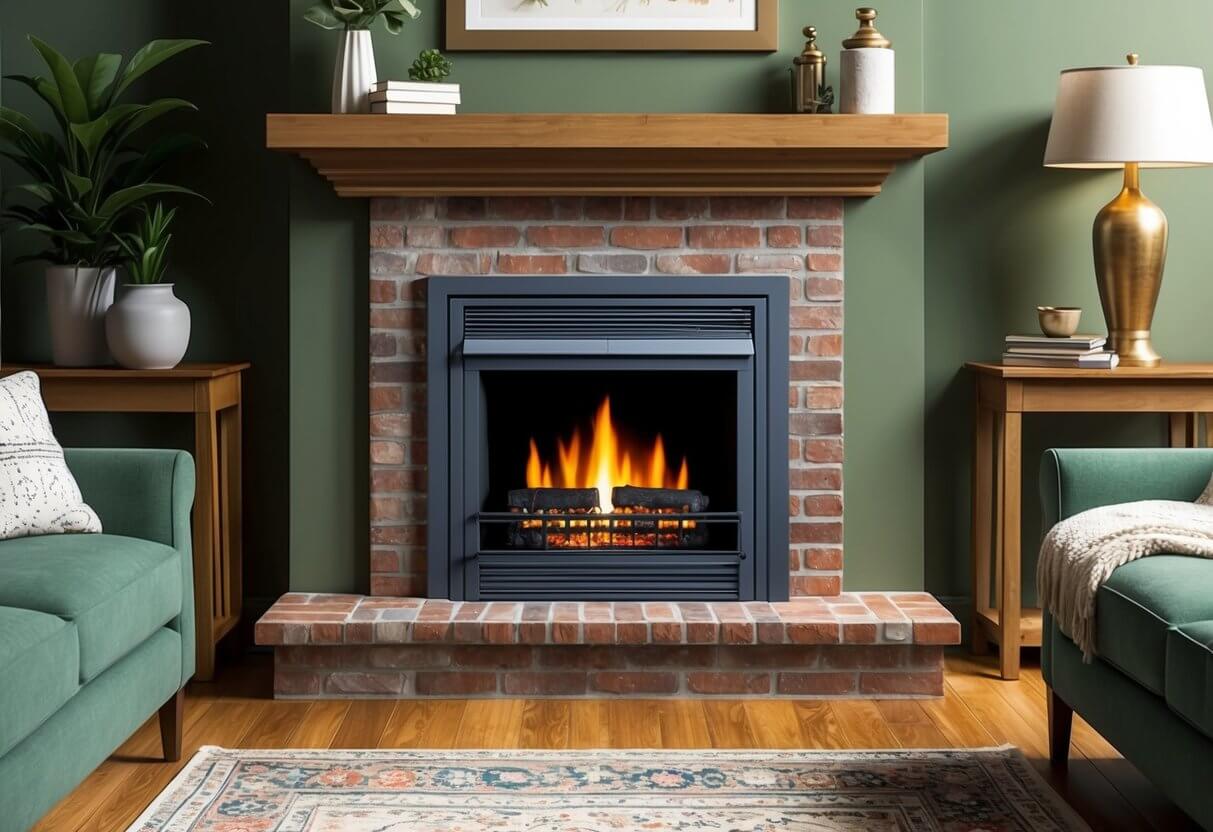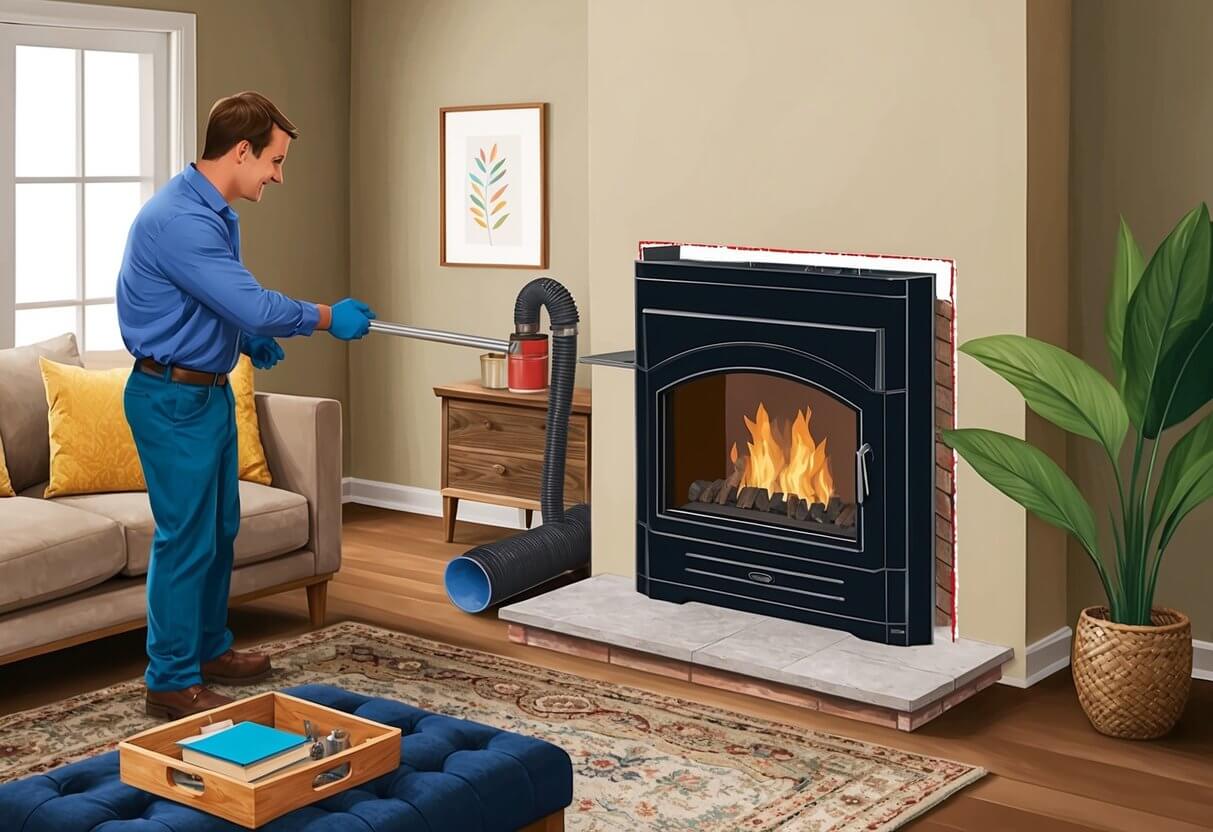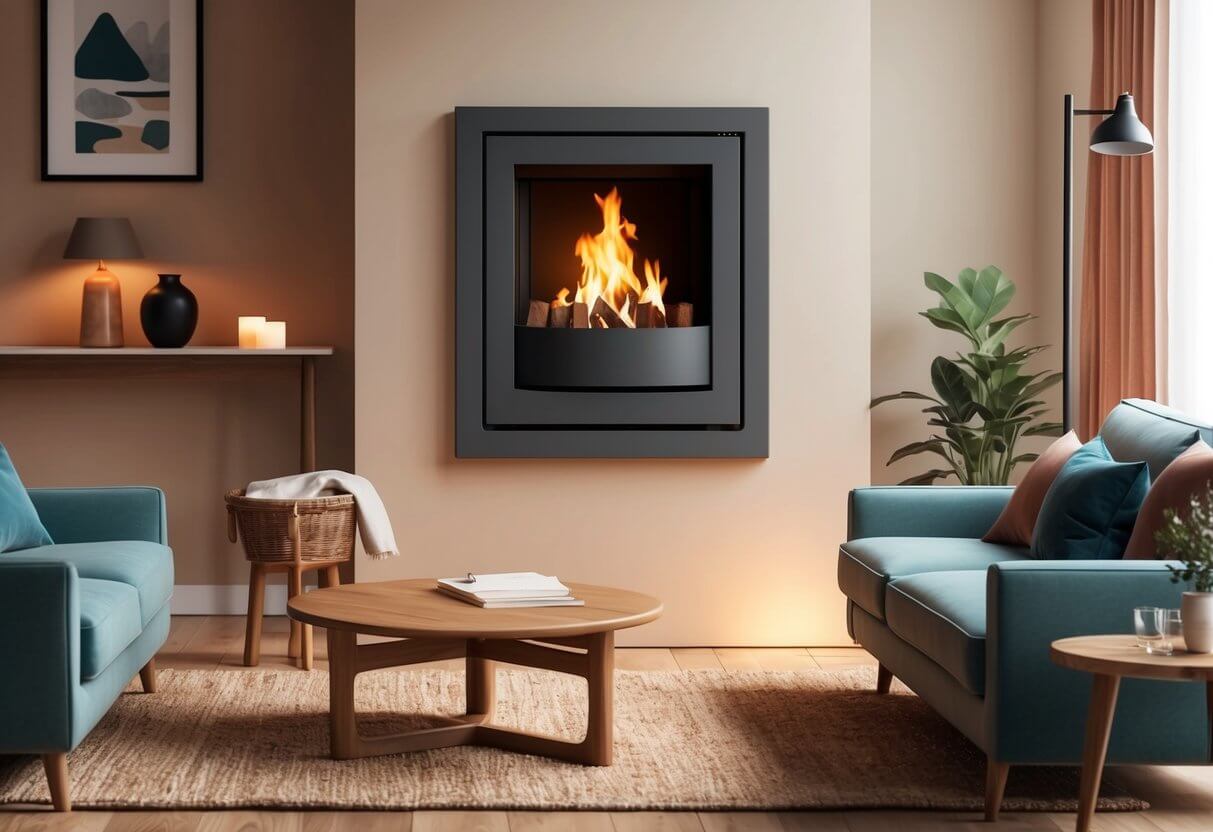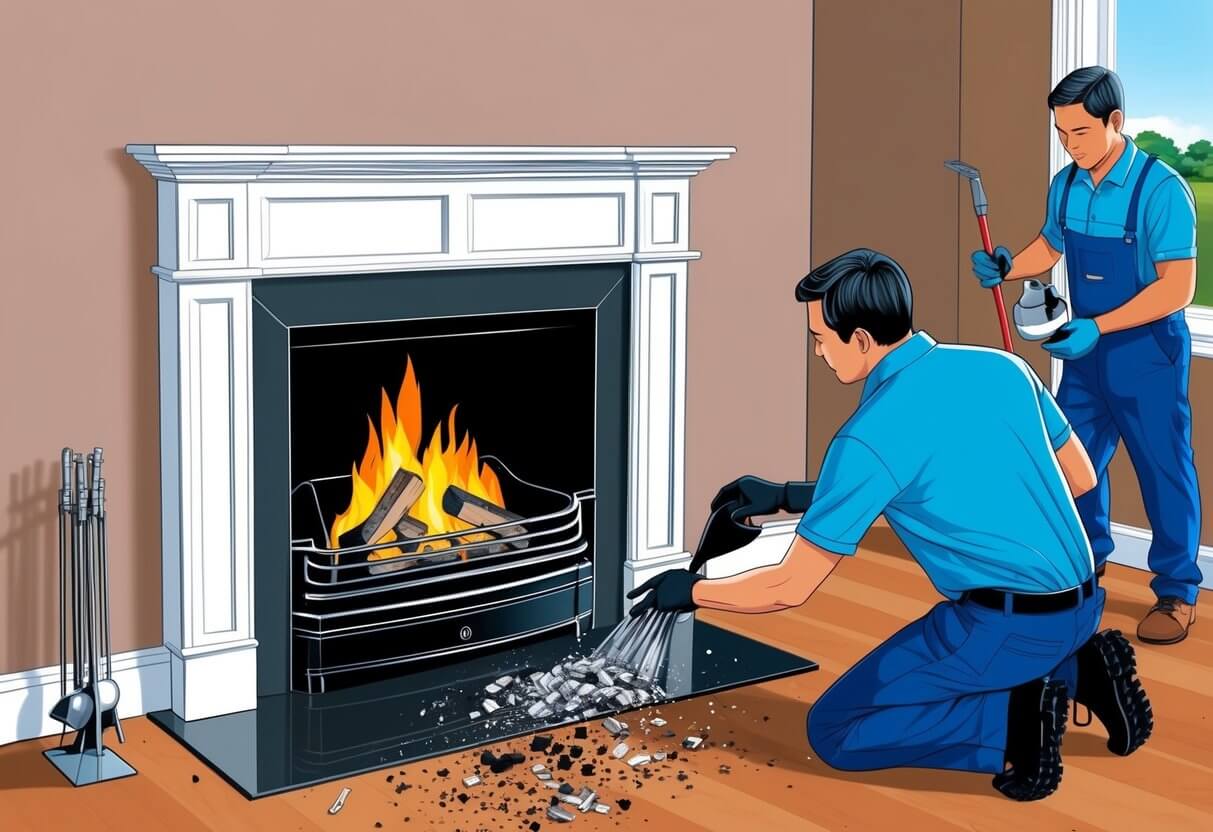Fireplaces with Inserts: Enhancing Efficiency and Aesthetic Appeal

Introduction
Fireplaces with inserts offer an attractive and efficient heating solution for our homes. These inserts enhance the functionality of traditional fireplaces, making them more efficient and eco-friendly. Whether we are considering a wood-burning or gas insert, understanding the options available can significantly improve our heating experience.
In this blog post, we will explore the various types of fireplace inserts, their installation requirements, and essential maintenance tips. We will also discuss how to select the right insert to match our home’s specific needs and preferences. By the end, we aim to equip ourselves with valuable insights to ensure a cozy and welcoming atmosphere during the cold months.
Key Takeaways
- Fireplace inserts improve efficiency and heat output in our homes.
- Selecting the right type of insert requires consideration of our heating needs and space.
- Regular maintenance is crucial to keep our fireplace inserts operating safely and effectively.
Types of Fireplace Inserts
Fireplace inserts come in various types, each offering unique features and benefits. We can select from gas, wood-burning, electric, and pellet stove inserts, depending on our preferences for fuel type, efficiency, and aesthetics.
Gas Fireplace Inserts
Gas fireplace inserts are popular for their convenience and efficiency. They can run on natural gas or propane, making installation flexible. Key features often include adjustable flame settings and venting options, which can be direct vent or vent-free, depending on the model.
Brands like Napoleon and Majestic offer a range of gas inserts that are EPA certified for efficiency and low emissions. With modifications, we can control these inserts using a remote or a timer. They provide heat quickly and evenly, making them an excellent option for those seeking user-friendly heating solutions.
Wood-Burning Fireplace Inserts
Wood-burning fireplace inserts bring a classic charm to our homes. They are designed to fit into existing fireplace openings, enhancing heat output and efficiency. Many models are EPA certified, guaranteeing reduced emissions and better heat retention.
These inserts can convert traditional fireplaces into functional heating sources while maintaining their aesthetic appeal. Brands like Regency and Hearthstone offer various options that integrate advanced technology, such as air wash systems for a cleaner burn. We benefit from the natural ambiance and fragrance of burning wood, making it a favorite for many.
Electric Fireplace Inserts
Electric fireplace inserts are an excellent choice for easy installation and maintenance. They simply plug into a standard outlet, providing instant warmth without the need for venting or fuel storage. This convenience allows us to enjoy a fireplace in any room without significant renovations.
Many electric models feature realistic flame effects and adjustable heat settings. Options equipped with timers and remote controls add to their appeal. Brands such as Dimplex and PuraFlame focus on providing stylish designs that can enhance our living space while being energy efficient.
Pellet Stove Inserts
Pellet stove inserts offer an environmentally friendly heating option. They burn compressed wood pellets, which are made from sawdust and can produce significantly lower emissions compared to other fuel sources. These inserts require a venting system for proper airflow.
Pellet stove inserts are known for their efficiency and low operating costs. Brands like Quadra-Fire and Enviro provide various size options that can cater to different spaces. Features may include digital controls, temperature settings, and automatic feed systems, allowing us to maintain consistent heating with minimal attention.
Installation and Venting Essentials
When considering gas fireplace inserts, we must pay close attention to installation and venting. These factors are crucial for ensuring not only efficient operation but also safety within our indoor spaces.
Professional Installation
For optimal performance and safety, we recommend opting for professional installation of gas fireplace inserts. Trained installers possess the expertise to properly connect gas lines and secure the insert. They ensure compliance with local building codes and safety regulations.
Key Benefits of Professional Installation:
- Expert Guidance: Professionals can recommend the best insert for our specific needs.
- Safety Assurance: Proper installation minimizes risks such as gas leaks or improper venting.
- Warranty Compliance: Many manufacturers require professional installation for warranty coverage.
Venting Systems
Venting is vital for the efficient operation of gas fireplace inserts, directly impacting indoor air quality and safety. There are two primary types of venting systems: direct-vent and ventless.
- Direct-Vent: This system draws air from outside for combustion and expels exhaust outside as well, creating a sealed environment. It is often preferred for its safety and efficiency.
- Ventless: This option does not require a flue, as it uses advanced technology to burn gas cleanly. However, it may have restrictions in some areas due to concerns about indoor air quality.
Choosing the right venting system is essential for achieving effective heating while ensuring a safe indoor environment.
Benefits of Insert Fireplaces
Insert fireplaces provide numerous advantages that enhance our home’s heating efficiency, aesthetic value, and environmental sustainability. By opting for these solutions, we can significantly improve our comfort while being mindful of our energy consumption.
Efficient Heating
One of the primary benefits of fireplace inserts is their exceptional efficiency in heating our homes. Traditional open fireplaces typically operate at just 5-10% efficiency, largely due to heat loss through the chimney. In contrast, wood fireplace inserts can improve this efficiency to as much as 80%.
The design of inserts allows for better airflow and heat retention. They contain the fire within a sealed firebox, leading to slower and hotter burns. This translates into more heat directed into our living spaces rather than escaping outdoors. Furthermore, the insulation helps reduce drafts, ensuring that warm air stays inside during colder months.
Aesthetic Appeal
Fireplace inserts also contribute significantly to the aesthetic value of our living spaces. They come in various styles and finishes, allowing us to match the insert with our home’s decor seamlessly. Whether we prefer a modern or traditional look, there are insert options to suit our tastes.
Additionally, inserts streamline the fireplace’s appearance, eliminating clutter associated with open fireplaces. By enhancing the overall design and functionality of the hearth, we can create a focal point in our homes that is both inviting and stylish. The glow of the fire becomes more pronounced, providing a cozy ambiance.
Environmental Considerations
Choosing fireplace inserts can be an environmentally friendly option for heating our homes. These inserts are designed to burn more efficiently, which means less fuel is required for the same heating output. As a result, we can decrease our carbon footprint by using less wood or gas, depending on the insert type.
Furthermore, many modern inserts are manufactured with eco-friendly materials and technology. Such designs help reduce smoke emissions and promote cleaner combustion, making them better for indoor air quality and the environment. With increased awareness of environmental issues, selecting a fireplace insert aligns our heating choices with sustainability goals, offering peace of mind alongside comfort.
Selecting the Right Insert for Your Home
When choosing the perfect fireplace insert, size and fuel type are crucial decisions. These factors impact efficiency, safety, and your overall satisfaction. Let us guide you through the process, ensuring you make the best choice. At Chimcare, we offer expert advice and top-quality service to help you find the perfect fit for your home. Trust us to handle the details, so you can enjoy a warm and efficient fireplace all year round.
Sizing and Fit
When selecting a fireplace insert, accurate sizing is crucial. We start by measuring the firebox in three dimensions: length, height, and depth.
- Length: Measure at both the front and back of the firebox.
- Height: Assess the distance from the firebox floor to the top, checking both ends.
- Depth: Measure from the opening to the back wall.
This attention to detail ensures a snug fit, which enhances efficiency and aesthetics. An insert that fits poorly can lead to heat loss and unsafe operating conditions.
Additionally, be aware of any additional surround that may be necessary if the insert does not entirely occupy the firebox. Not only does this define the look, but also affects how heat is distributed throughout your home.
Fuel Type and Availability
Fuel type is another significant factor in choosing an insert. We typically have options like wood, natural gas, propane, and electricity. Each option has its own set of advantages:
- Wood Stove Inserts: Often more cost-effective, they provide a traditional ambiance. Prices can vary widely based on brand and features.
- Natural Gas and Propane: These are convenient and cleaner-burning alternatives. They require specific venting setups, like vent-free or direct vent options. Brands often offer features that enhance reliability and controls for temperature.
- Electric Inserts: Generally easier to install with no venting needed, these inserts can offer additional features such as adjustable flame effects and programmable settings.
Before finalizing the decision, we should consider the availability of the chosen fuel type in our area, as this will impact ongoing costs and convenience.
Maintenance and Upkeep
Regular maintenance of fireplace inserts ensures their longevity, safety, and efficiency. Proper cleaning protocols are essential to maintain functionality, while long-term care practices will help us preserve the durability and cost-effectiveness of our systems.
Cleaning Protocols
For effective cleaning, we recommend performing a thorough inspection and cleaning at least once a year. Gas inserts typically require less frequent cleaning, while wood inserts demand more diligence due to ash accumulation.
Cleaning Steps:
- Remove Components: Detach logs and any decorative features.
- Clean Interior: Use a brush or vacuum suited for ash removal.
- Inspect Venting: Ensure the venting system is clear of blockages.
- Professional Cleaning: Engage a chimney sweep annually for a comprehensive service to enhance safety.
Regular cleaning not only maintains performance but also minimizes fire hazards, enhancing safety and ensuring our fireplaces operate efficiently.
Long-term Care
To prolong the life of our fireplace inserts, we should adopt routine care practices. This includes monitoring for cracks or corrosion, which can compromise safety and functionality.
Care Tips:
- Routine Inspections: Check for signs of wear at least twice a year.
- Flue Maintenance: Ensure the flue is clean and unobstructed.
- Ensure Proper Operation: Regularly test the system to confirm it starts and operates safely.
Investing in long-term care reduces the risk of costly repairs and enhances the durability of our fireplace inserts. Consequently, we not only save money but ensure a safer environment for our homes.
Frequently Asked Questions
In this section, we address common inquiries regarding fireplace inserts. Our focus includes their benefits, modifications, efficiency enhancements, maintenance needs, and implications for home insurance.
What are the benefits of using a fireplace insert?
Fireplace inserts offer several advantages over traditional open fireplaces. They are designed to improve heating efficiency and reduce emissions. Inserts create a closed combustion system, allowing for better air control and enhanced heat retention.
Can you convert a traditional fireplace into a gas insert model?
Yes, converting a traditional fireplace to a gas insert is a common practice. This process involves installing a gas line and fitting the insert into the existing structure. Consulting with a professional ensures compliance with safety and building codes.
How do fireplace inserts with blowers enhance heating efficiency?
Inserts equipped with blowers circulate warm air more effectively throughout a room. By pushing heated air away from the unit, they maximize the distribution of warmth. This leads to a more uniform and efficient heating experience.
What is the difference between a wood fireplace insert and a wood burning stove?
Wood fireplace inserts fit directly into an existing fireplace, while wood burning stoves are standalone units. Inserts generally provide a more integrated look and utilize the existing chimney. Stoves, on the other hand, can be placed in various locations and typically offer more heat output.
Are there any specific maintenance requirements for electric fireplace inserts?
Electric fireplace inserts require minimal maintenance compared to their wood or gas counterparts. Regular cleaning of the exterior and replacing the light bulbs as needed are the primary tasks. It’s essential to follow the manufacturer’s guidelines for optimal performance and safety.
How does the installation of a fireplace insert affect home insurance?
Installing a fireplace insert can influence home insurance premiums. Insurers may view inserts as a safety improvement, potentially leading to reduced rates. It’s advisable to notify your insurance company before installation to ensure coverage aligns with your new setup.

 We Ship Anywhere USA & Canada
We Ship Anywhere USA & Canada






